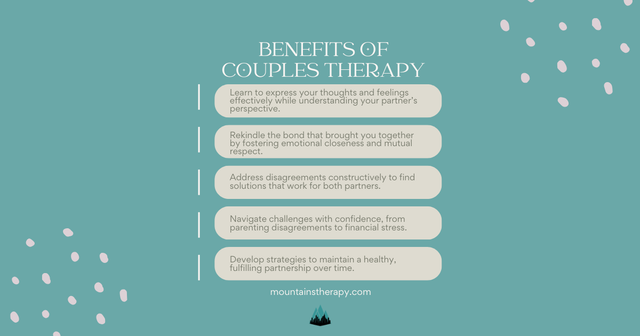7 Easy Facts About Aim Point Counseling Explained
7 Easy Facts About Aim Point Counseling Explained
Blog Article
The Best Guide To Aim Point Counseling
Table of ContentsNot known Factual Statements About Aim Point Counseling 8 Easy Facts About Aim Point Counseling DescribedTop Guidelines Of Aim Point CounselingThe Ultimate Guide To Aim Point CounselingWhat Does Aim Point Counseling Mean?The Single Strategy To Use For Aim Point Counseling
The longitudinal design includes a pre-treatment study and 2 follow-up studies at 3- and 12-months post-intervention. The research is established in 8 Relationships Australia Victoria centres, across cosmopolitan, external suburbs, and regional/rural sites. Relationships Australia, a non-government organisation, is the biggest company of pair therapy and partnership solutions in Australia.
In Australia, the typical size of marital relationship prior to splitting up is 8.8 years, and around fifty percent of all separations entail pairs with kids [1] These high prices of connection failure have been regularly linked with unfavorable health and wellness effects for both grownups and youngsters adhering to divorce/separation. These consist of isolation from support networks, and decreased revenue and standard of living for both adults and kids [3], issues of commitment over children for men, and depression and loss of identity for females [4,5]
Little Known Questions About Aim Point Counseling.
Longitudinal research studies additionally suggest that children of separation have a greater occurrence of psychological disorders, medication and alcohol use, and dangerous sex-related behaviour [7] Although the results of separation and separation can be detrimental, study shows that high connection dissonance in undamaged couples is also likely to have adverse end results.
Moreover, elements that influence the end results of these services need comprehensive investigation. Research study to day has actually identified both pair and specific variables that may add to relationship dissonance. These consist of partnership contentment and commitment at the pair degree, and depression at the individual level. Nonetheless, durable study to evaluate relationship-enhancing interventions in the area are limited.
The Best Guide To Aim Point Counseling
Connection contentment has actually been the most usual result variable determined in more than 200 analyses of pair therapy [11,12] Researches have actually found considerable enhancements in relationship satisfaction from pre- to post-treatment [13,14] and throughout one to two years adhering to therapy [15] In these research studies, partnership fulfillment was most frequently analyzed utilizing the Dyadic Change Scale (DAS) [16] While many researches suggest renovations in relationship fulfillment adhering to pair coaching, they are limited by the examples and steps utilized, largely short-term follow-up time structures, and evaluations that do not account for the dyadic nature of couple data., is an additional typically checked out partnership result.
To summarise, research study indicates that couple-specific variables in addition to individual factors may anticipate the outcomes of pair counselling and partnership solutions. The causal direction of these partnerships, nevertheless, is less clear. These observations are crucial, given that, to validate and guide the application of partnership solutions such as pair therapy, empirical proof must explore both the outcomes of partnership solutions and the elements that predict successful therapy.
, at least in some European nations.

We currently know little regarding the accounts of couples that choose partnership education compared with those who look for connection therapy, or the outcomes of these programs. Nonetheless, unscientific evidence suggests that there might useful reference be significant distress among a minimum of some couples seeking relationship education. Partnership education programs differ from couple counselling as they are typically very structured, performed in teams, and concentrate on a blend of four components; awareness, comments, cognitive change, and abilities training [45]
A Biased View of Aim Point Counseling
Responses entails participants finishing sets of questions about their partnership (e.g. steps of social problems), and receiving details on what their scores suggest. Cognitive-behavioural techniques advertise altering cognitions to assist in positive partnerships. These might include promoting realistic attributions/expectations around unfavorable companion behaviour [46] In abilities training, couples go to talks or discussions on connection abilities, and practice these during facilitator-led activities [ 45]
These effects have lingered for up to 4 years in some researches [47] These meta-analyses highlight restrictions in the current literary works on connection education and learning. Specifically, the bulk of studies entailed couples from upper socio-economic backgrounds that were not experiencing high partnership discord [47,48] This sample profile might not represent customers that commonly offer for relationship education.
About Aim Point Counseling

Extremely little study has actually analyzed the relative benefits of pair counselling and relationship education and learning programs. As clients are most likely to self-select into these service types, it is not clear whether particular relationship distress accounts existing per service kind, or indeed whether there is a communication between presenting profile, solution kind and outcome.
(https://medium.com/@toddrashid01/about)
Therefore, we have actually consisted of a 12-month follow-up to gauge longer-term fads and impacts.
We suggest to make use of multi-level analytical modelling treatments that manage for the inter-dependence of pair data to evaluate any type of treatment effects. The details purposes of the ECC research study are to: 1. Map profiles of customers seeking neighborhood agency-based couple therapy vs. connection enhancement programs in regards to socio-demographic and partnership indications (such as connection satisfaction, connection commitment, social issues, and reasons for participating in), in addition to health and wellness (such as clinical depression, general wellness) and health service use (eg.
2. Identify whether couple therapy and connection education and learning services boost 3- and twelve-month outcomes for connection contentment, dedication, and depression, using analytical evaluations appropriate to pair data. 3. Figure out the loved one payments of customer variables (specific and couple) and therapy/education variables to results at 3- and 12-months, and to sustainability of outcomes in time.
9 Easy Facts About Aim Point Counseling Explained
Multi-level modelling to determine pre-post differences, controlling for dyadic (pair) level. To contribute to the literary works analyzing the effectiveness of community-based couple counselling. The results will aid scientific decision-making in community-based relationship service settings, and specialist training. 3. To establish the loved one contributions of client/couple and treatment aspects to end results at 3- and 12-months, and to sustainability of outcomes with time.
Report this page